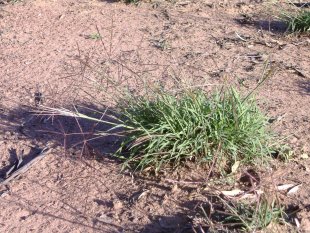
Curly Windmill grass
SCIENTIFIC NAME: Enteropogon acicularis and E. ramosus
CATEGORY: C4 perennial
IDENTIFICATION TIPS
- Tufted, warm-season long-lived perennial to 1m tall
- Seedhead digitate, with long stiff branches arranged in several planes like wheel spokes. Spikelets awned and not blunt-tipped
- Flowers from spring to autumn in response to rain
CLIMATIC & SOIL REQUIREMENTS
- One of the most widespread and common species
- Found on all soil types, although more common on red soils and in lightly grazed areas
- High drought, moderate frost and good flood tolerance
GRAZING & NUTRITIONAL VALUE
- Low to moderate grazing value
- Digestibility ranges from 37-62%
- Crude protein 5-13%
MANAGEMENT STRATEGIES
- Produces good growth after rain from spring to autumn
- Young growth is moderately palatable, but flowering plants are harsh and left ungrazed
- Produces some winter growth, but this is ignored by stock if other palatable species are present
- Seedling recruitment is infrequent
- Can increase under light to moderate stocking rates, but is eliminated under heavy stocking
- Rest pastures when there are good prolonged summer rains to aid seedling establishment
SIMILAR PLANTS
- Both Enteropogon species have broadly overlapping distributions. In the past they have been mistakenly combined in the literature, making it difficult to confidently determine the quality and management requirements of each species
- E. acicularis grows to 40cm tall and has hairy stems and leaves. The leaves are rarely twisted and arise from the base of the plant. There are 7-22 branches in the seedhead
- Enteropogon ramosus grows 60-100cm tall and is hairless. The leaves are often twisted and arise from branched stems. There are usually 6 branches in the seedhead
- Windmill grass (Chloris truncata) has blunt-tipped spikelets that are black when mature

(Flowering plant: K Hertel)

